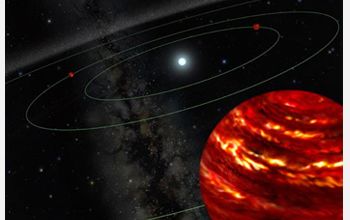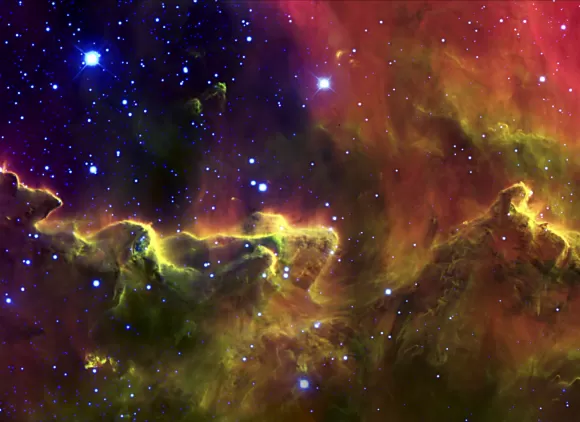
Credit: Gemini Observatory Artwork by Lynette Cook
The field of astronomy is entering a new era. In the next two decades, a new class of telescope — known as Extremely Large Telescopes — can be built with capabilities well beyond that of space-based telescopes.
These new telescopes will explore the signatures of life on other worlds, answering fundamental questions about humans' place in the universe: Is there other life out in the vast expanse of space? Are there other worlds with life that future generations can explore?
NSF is considering a potential future investment in the construction and operations of an Extremely Large Telescope in the Northern Hemisphere, the Thirty Meter Telescope.
NSF understands that the possible construction of an Extremely Large Telescope on Maunakea, Hawai‘i Island, Hawaii, is a sensitive issue that requires extensive engagement and understanding of various viewpoints.
NSF will not make a funding decision until after it considers the following:
- Public input.
- The environmental review of the telescope.
- The project's technical readiness.
- The project proponent's management capabilities.
- The availability of federal funding.
- The telescope's alignment with other NSF priorities.
Note: A decision by NSF not to go forward with an investment in the construction and operations of the Thirty Meter Telescope could be made at any time, including before the environmental review process has concluded.
Where is NSF in its environmental review process?
Previously, NSF has:
- Conducted public scoping under the "National Environmental Policy Act" (July 19–September 17, 2022). See Resources for related materials.
- Invited public comment on its draft Community Engagement Plan (July 19–September 17, 2022).
Currently, NSF is:
- Identifying consulting parties to engage with during Section 106 consultation process under the "National Historic Preservation Act."
Email ConsultingParty.TMT@nsf.gov to request to be a consulting party.
- Evaluating comments received during the July 19–September 17 scoping comment period and considering how the comments will inform the next steps in the environmental review.
UPDATES| March 22, 2024
Following consulting party invitations in December 2023, the U.S. National Science Foundation has been reaching out to confirm invitees' interest in participating in Section 106 of the "National Historic Preservation Act" consultation regarding a potential NSF investment in the construction and operation of the Thirty Meter Telescope. NSF is planning for the first series of Section 106 meetings to take place during the spring/summer of 2024 or later based on planning needs.
January 19, 2024
- In December 2023, NSF reached out to those who had expressed interest in participating in Section 106 of the "National Historic Preservation Act" consultation regarding a potential future NSF investment in the construction and operation of the Thirty Meter Telescope. NSF invited them to confirm their interest in serving as a consulting party in the Section 106 process. Native Hawaiian Organizations, individuals & organizations (including ‘ohana), local government representatives and the funding applicant may self-identify as a party with a consultative role in the Section 106 process consistent with the direction provided by the Advisory Council on Historic Preservation. See the
for more information.
If you did not receive a letter but self-identify as a party with a consultative role under 36 CFR 800.2(c), please email consultingparty.tmt@nsf.gov to request to be a consulting party. NSF will continue to refine the consulting party list based on responses and will provide consulting parties with an invitation to the first series of Section 106 meetings, which will occur throughout the Hawaiian Islands during the first half of the 2024 calendar year.
Note that Section 106 of the "National Historic Preservation Act" consultation involves a four-step process focused on historic properties and is separate from the environmental review process conducted under the "National Environmental Policy Act" (NEPA). Those who do not participate in the Section 106 consultation may still participate in the NEPA process, including commenting on draft study plans when they are posted to this website and on the draft environmental impact statement that will be prepared following completion of the studies.
Additional resources:
Council on Environmental Quality's A Citizen's Guide to NEPA, Having Your Voice Heard
Advisory Council on Historic Preservation's Introduction to Section 106
November 9, 2023
- NSF appreciates the immense community input provided during public scoping and learning about potential cultural and natural impacts on Maunakea. NSF is also aware of the work being done by the Mauna Kea Stewardship and Oversight Authority (MKSOA). To ensure there is no interference with the MKSOA, NSF is taking a careful approach in conducting its environmental review by adding more time into its estimated schedule.
Additionally, the public feedback made it clear that adjustments must be made in the Section 106 consultation process under the "National Historic Preservation Act." The NSF team has been actively assessing what adjustments need to be made to the environmental review process in light of the thousands of public comments received. The agency is committed to conducting expansive Section 106 meetings across the state of Hawaiʻi and collaborating with those who will be participating as “consulting parties” in the Section 106 process.
NSF will be reaching out soon to over 150 Native Hawaiian Organizations and individuals, including those who have expressed interest, to serve as consulting parties. The agency anticipates that the first series of Section 106 meetings will be held during the first half of 2024.
- See the new Frequently Asked Questions, including: "Why did NSF provide funding for TMT design and development work when the environmental review is not yet complete?”
March 23, 2023
- NSF is continuing to consider how the comments submitted by interested members of the public, agencies and organizations will inform the next steps in the environmental review.
NSF intends to amend the process timeline to accommodate the additional time required to fully review and process public scoping comments; the original timeline that was posted during scoping, shown in meeting materials and in Section 3 of the Draft Community Engagement Plan, is now out of date. NSF will post updates to the process timeline and the Community Engagement Plan to the website once they are available.
If you would like to be notified of additional updates please sign up to our TMT subscriber list.
- See the new Frequently Asked Question: "Would an Action Alternative involving a proposed NSF investment in TMT on Maunakea be subject to the requirements of the Mauna Kea Stewardship and Oversight Authority (established by Hawaii Act 255)?”
January 2023
- NSF is amending the environmental review process timeline to ensure the agency can fully review the large volume of comments it received during the public comment period.
The original timeline posted by NSF during public scoping, shown in Section 3 of the Draft Community Plan, is now out of date. NSF will post updates to this website once they are available.
If you have questions about the process, please contact us at EIS.106.TMT@nsf.gov.
- January 3rd email (PDF, 340.48 KB)
Materials from NSF's public scoping meetings:
NSF hosted a series of public scoping meetings in Hawaii from August 9–12, 2022. All meetings included a presentation followed by a public comment period inviting oral and written comments. Materials shared at those meetings can be found below:
Related links:
- Read the National Academies of Science, Engineering and Medicine's 2020 Astronomy and Astrophysics Decadal Survey.
- Visit the Thirty Meter Telescope project proponent's About page.



